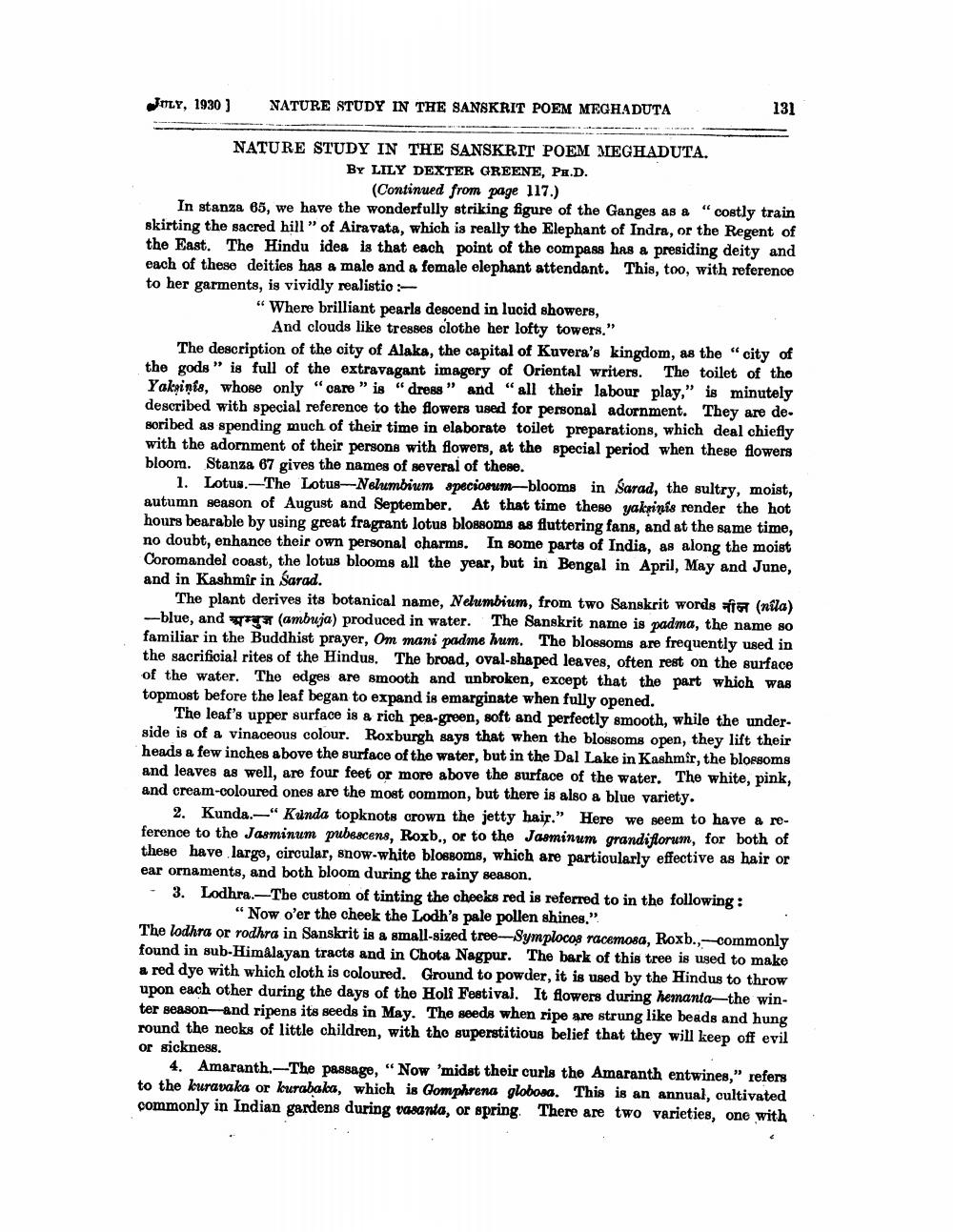________________
Imy, 1930)
NATURE STUDY IN THE SANSKRIT POEM MEGHADUTA
131
NATURE STUDY IN THE SANSKRIT POEM MEGHADUTA.
BY LILY DEXTER GREENE, PH.D.
(Continued from page 117.) In stanza 65, we have the wonderfully striking figure of the Ganges as a "costly train skirting the sacred hill" of Airavata, which is really the Elephant of Indra, or the Regent of the East. The Hindu idea is that each point of the compass has a presiding deity and each of these deities has & male and a female elephant attendant. This, too, with reference to her garments, is vividly realistio
"Where brilliant pearls descend in lucid showers,
And clouds like tresses clothe her lofty towers." The description of the city of Alaka, the capital of Kuvera's kingdom, as the “city of the gods" is full of the extravagant imagery of Oriental writers. The toilet of the Yaksinis, whose only "care" is "dress" and "all their labour play," is minutely described with special reference to the flowers used for personal adornment. They are desoribed as spending much of their time in elaborate toilet preparations, which deal chiefly with the adornment of their persons with flowers, at the special period when these flowers bloom. Stanza 67 gives the names of several of these.
1. Lotus.-The Lotus ---Nolumbium speciosum-blooms in Sarad, the sultry, moist, autumn season of August and September. At that time these yakrinis render the hot hours bearable by using great fragrant lotus blossoms as fluttering fans, and at the same time, no doubt, enhance their own personal charms. In some parts of India, as along the moist Coromandel coast, the lotus blooms all the year, but in Bengal in April, May and June, and in Kashmir in Sarad.
The plant derives its botanical name, Nelumbium, from two Sanskrit words to (nila) --blue, and we (ambuja) produced in water. The Sanskrit name is padma, the name so familiar in the Buddhist prayer, Om mani padme hum. The blossoms are frequently used in the sacrificial rites of the Hindus. The broad, oval-shaped leaves, often rest on the surface of the water. The edges are smooth and unbroken, except that the part which was topmost before the leaf began to expand is emarginate when fully opened.
The leaf's upper surface is a rich pea-green, soft and perfectly smooth, while the underside is of a vinaceous colour. Roxburgh says that when the blossoms open, they lift their heads a few inches above the surface of the water, but in the Dal Lake in Kashmir, the blossoms and leaves as well, are four feet or more above the surface of the water. The white, pink, and cream-coloured ones are the most common, but there is also a blue variety.
2. Kunda.“ Kunda topknots crown the jetty hair." Here we seem to have a reference to the Jasminum pubescens, Roxb., or to the Jasminum grandiflorum, for both of these have large, circular, snow-white blossoms, which are partioularly effective as hair or ear ornaments, and both bloom during the rainy season. - 3. Lodhra. The custom of tinting the cheeks red is referred to in the following:
"Now o'er the cheek the Lodh's pale pollen shines.” The lodhra or rodhra in Sanskrit is a small-sized tree-Symplocos racemosa, Roxb., --commonly found in sub-Himalayan tracts and in Chota Nagpur. The bark of this tree is used to make a red dye with which cloth is coloured. Ground to powder, it is used by the Hindus to throw upon each other during the days of the Holi Festival. It flowers during hemanta—the winter season and ripens its seeds in May. The seeds when ripe are strung like beads and hung round the necks of little children, with the superstitious belief that they will keep off evil or sickness.
4. Amaranth. The passage, “Now 'midst their curls the Amaranth entwines," refers to the kuravaka or kurabala, which is Gomphrena globosa. This is an annual, cultivated commonly in Indian gardens during vasanta, or spring. There are two varieties, one with




